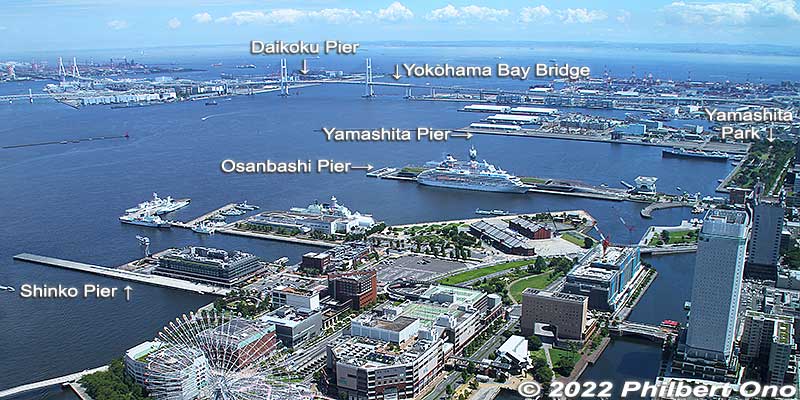
by Philbert Ono, updated: July 20, 2023
Japan’s most historic and popular cruise ship departure port.
Located on the west side of Tokyo Bay, Port of Yokohama is Japan’s most historic and storied port since it opened in 1859. Along with Kobe, Yokohama was Japan’s main international gateway until air travel became dominant from the 1960s.
Although it has been well expanded, developed, and modernized, Yokohama Port still has historical remnants of the port’s early years. Historic buildings, piers, crane, and even the tree that witnessed the signing of the treaty that opened Japan to the U.S. still exist.
The great city of Yokohama was basically founded with the opening of the port. It still has a very strong identity as a port town and international city. The port area is readily accessible from central Yokohama and full of enjoyable spots including cruise ship terminals.
Yokohama is Japan’s top departure port for cruise ships, favored more than Tokyo because it’s closer to the mouth of the bay and Pacific Ocean.
Yokohama Port’s cruise ship piers
For cruise ships, three piers are available in Yokohama: Osanbashi, Daikoku, and Shinko Piers.
Osanbashi Pier (“Big Pier” 大さん橋ふ頭) is the most famous one with a full-scale cruise terminal building. It’s Yokohama’s first modern pier where many passenger ships have docked. Until the 1960s, many foreign tourists first set foot on Japan on this pier. Centrally located next to Yamashita Park.
Osanbashi Pier’s two-story Osanbashi Yokohama International Passenger Terminal (横浜港大さん橋国際客船ターミナル) was built in 2002 to replace the old building built for the 1964 Tokyo Olympics.
Already 20 years old, the Osanbashi cruise terminal building is nicknamed “Whale’s Back” (クジラの背中) because of its long, hump-like roof. Inside the terminal is a long, cavernous hall appropriately nicknamed “Whale’s Stomach” (クジラのおなか). The building is very well designed for both function and form.
The building has CIQ, PCR testing facilities, passenger waiting area, boat gates, a few gift shops, cafe, information counter, and a nice rooftop park (wooden deck and lawn) open 24/7 where the public can see cruise ships come and go. It’s a tourist attraction. The terminal building is also used as an event hall.
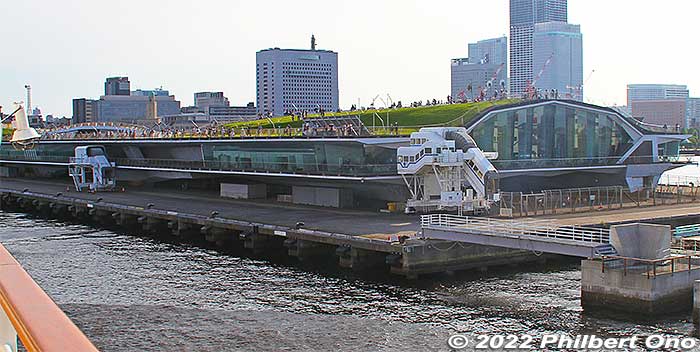
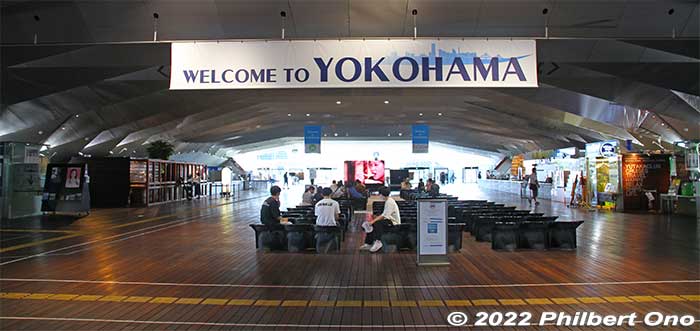


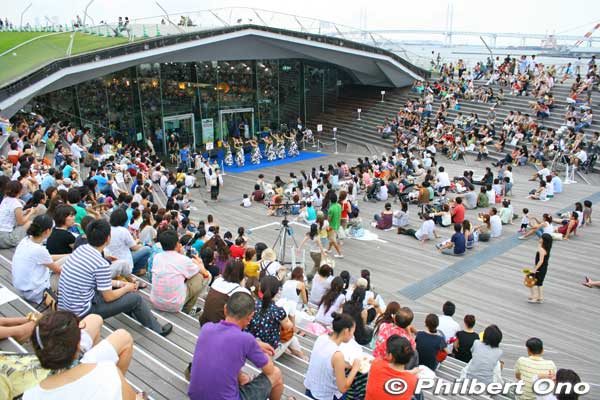
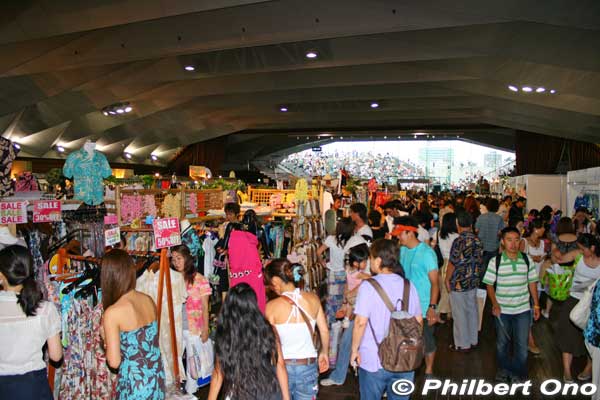
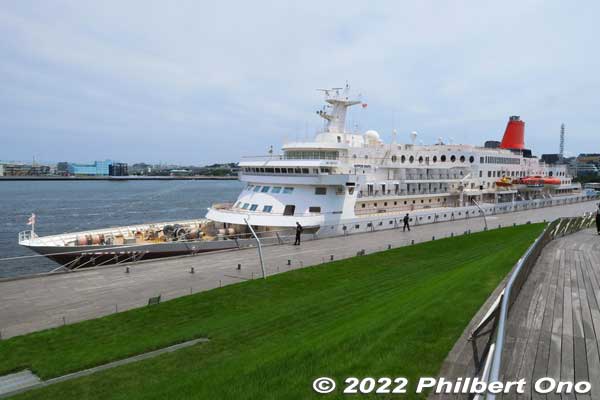

Osanbashi is centrally located, within walking distance to the Red Brick Warehouses, Yamashita Park, Yokohama Marine Tower (just reopened after major renovations), and Hikawa Maru museum ship. In the distance, you can see Yokohama Bay Bridge which opened in 1989.
For shopping, there’s a large drugstore/supermarket in Silk Center/Museum a short walk away. Nihon-Odori subway station is also convenient to visit Tokyo (Shibuya, etc.). Local buses stopping at Osanbashi go to JR Sakuragicho Station. (More nearby sights listed below.)
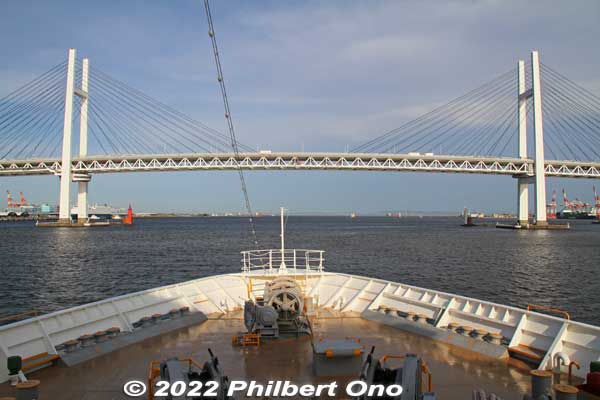
The thing about Osanbashi Pier is that cruise ships must go under Yokohama Bay Bridge. Japanese cruise ships have no problem. However, international mega-ships usually cannot clear the bridge, so instead of Osanbashi, they dock at Daikoku Pier right outside Yokohama Bay Bridge.
Recognizing the need for a pier for mega-ships, Daikoku Pier was converted into a cruise ship dock. It used to be a dock for car carriers or Ro-Ro ships. The Daikoku Pier Passenger Terminal (大黒ふ頭客船ターミナル) was also built in spring 2019.
The first ship to use the new terminal was none other than the new Queen Elizabeth mega-ship on April 19, 2019. Back in 2014, Queen Elizabeth managed to dock at Osanbashi by going under Yokohama Bay Bridge at low tide.
Daikoku Pier was also where the COVID-19-stricken Diamond Princess was moored during its quarantine in Feb. 2020.
However, Daikoku Pier is somewhat far from central Yokohama. Not a convenient location like Osanbashi or Shinko Pier. Passengers will need to get on a bus or car to get to town. This means less time for local sightseeing. It’s not a tourist attraction like Osanbashi either.
But on weekends, you can go up the Yokohama Bay Bridge elevator and walk partially across the bridge to a lookout lounge (Skywalk) to watch ships pass under the bridge.
Shinko Pier (新港ふ頭) is another new dock for cruise ships. Convenient location and close to large shopping malls and sights in the Minato Mirai commercial area.
Nicknamed “Yokohama Hammerhead,” the new two-story Shinko Pier Cruise Terminal (新港ふ頭客船ターミナル) opened in Nov. 2019 with the Diamond Princess being the first to dock. The cruise terminal has CIQ facilities and is a small mall of shop, restaurants, and hotel. However, ships still must clear Yokohama Bay Bridge to get to Shinko Pier.
Shinko Pier is within walking distance (15 min.) to JR Sakuragicho Station as well. Or you can ride the new Yokohama Air Cabin 630-meter ropeway between JR Sakuragicho Station and near Shinko Pier, World Porters mall, and the Red Brick Warehouses. The ride is only 5 minutes. Great bird’s eye views if you’re not afraid of heights (acrophobia). One-way fare is ¥1,000 (¥1,800 roundtrip) and ¥500 for kids. It opened in April 2021.
Yamashita Pier on the opposite end of Yamashita Park is also available to cruise ships if necessary, however, it is still undeveloped. The city intends to develop this large pier too, but no final plans yet. A while back, there was a proposal to develop this pier area into an Integrated Resort (IR) to include a casino. However, this proposal was shot down with the election of a new mayor.
The city then asked for pier development proposals from the public from Dec. 2021 to June 2022. Ten proposals came from major Japanese construction companies and other organizations to build an international trade show hall, concert/event hall, sports arena, hotel, cruise ship terminal, fresh food market, pedestrian deck, and other facilities.
Yokohama Port history
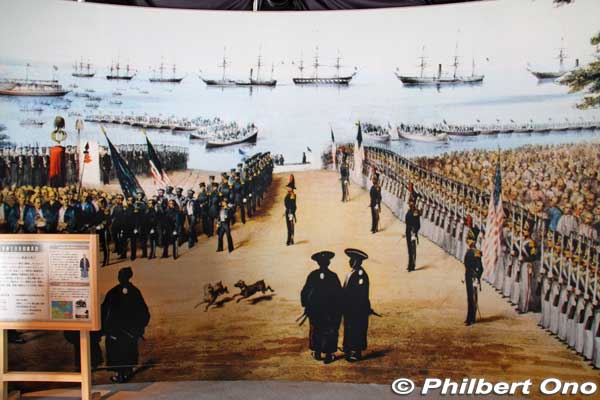

Historically, Yokohama Port got a head start over Tokyo Port when it was designated as one of the five treaty ports opened to U.S. ships by Treaty of Amity and Commerce between Japan and the United States (Harris Treaty) signed in July 1858. The samurai government wanted to keep foreigners at a distance from the nation’s capital of Edo (Tokyo). So the sleepy fishing village of Yokohama (then called Kanagawa) was selected.
The treaty opened Yokohama (Kanagawa) and Nagasaki, and later Niigata and Kobe (Hyogo) to American ships and allowed Americans to live at the treaty ports.
Yokohama opened to international trade on July 1, 1859. Yokohama became prominent enough to be one end of Japan’s first railway that ran between Shimbashi Station and Yokohama (Sakuragicho) in 1872.
However, it took about 30 years before the Meiji government finally decided to modernize and develop the still-primitive Yokohama Port (instead of Tokyo Port).
Ships still could not moor directly to piers, forcing barges and tender boats to shuttle between the ships and dock. It was a time-consuming step and problematic when the port kept getting busier with more ships.

To resolve these problems, Osanbashi Pier was finally built in 1894. Corkscrew piles were imported to dig into the seabed to construct a long, steel pier with deep enough water. Ships could finally dock directly to the pier. In the early years, Osanbashi Pier didn’t have an official name and people just nicknamed it “Tetsu-sanbashi” (鉄桟橋) or Steel Pier. It became the main dock for ocean liners.
Osanbashi was rebuilt a number of times and the expansion and development of Yokohama Port has continued ever since except for two major interruptions: the Great Kanto Earthquake in 1923 and World War II.
On September 1, 1923, the Great Kanto Earthquake killed over 100,000 and inflicted heavy damage to Yokohama and Tokyo including the ports.
When the quake struck, three passenger ships were moored at Yokohama’s Osanbashi Pier. One of them was Canada-flagged RMS Empress of Australia which was just about to leave Yokohama. However, the pier collapsed and caught fire, trapping many people on the pier who were seeing off the ship.
The ship’s captain, Samuel Robinson, conducted rescue operations with ladders and ropes for people trapped on the dock to climb aboard. Lifeboats were also sent ashore to rescue people in need. The ship remained in Yokohama for 12 days to provide relief. She then took thousands of refugees to safety in Kobe. Captain Robinson was widely hailed as a hero in Japan and Canada.
A few other international ships in Yokohama also provided similar relief to people in need.
Yokohama Port was rebuilt bigger and better than ever before. Osanbashi Pier was fully repaired by September 1925. In 1930, Yamashita Park was made with reclaimed land using Yokohama’s 1923 earthquake rubble.
From the late 19th century and early 20th century, thousands of Japanese emigrants departed Yokohama and Kobe Ports to Hawaii, North America, and South America to work as laborers. Emigration inns were set up near Yokohama and Kobe Ports where emigrants stayed temporarily before boarding the ship.
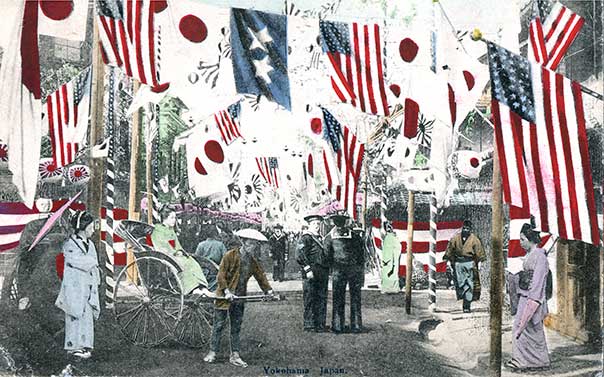
In October 1908, Yokohama saw the biggest navy fleet ever when the U.S. Navy’s Great White Fleet anchored off Yokohama Port during its world cruise. Streets of Yokohama were festooned with Japanese and American flags. The local people warmly welcomed the ships and sailors.

Osanbashi Pier saw many celebrities traveling to or from Japan such as Charlie Chaplin on the Hikawa Maru in 1932, Babe Ruth when he came with the U.S. All-Star team on the Empress of Japan in 1934, and Helen Keller when she boarded the Asama Maru back to the U.S. (San Francisco).
Famous Japanese using Osanbashi include judo founder Kano Jigoro when he traveled to Cairo, Egypt to attend an International Olympic Committee Session in 1938 (died on the Hikawa Maru on the return trip). In 1932, the 192-member Japanese Olympic team sailed from Yokohama to San Francisco to compete at the Los Angeles Olympics. In September 1945, the boat that took the Japanese contingent to the USS Missouri in Tokyo Bay to sign the Japanese Instrument of Surrender left from Osanbashi.
World War II (1941–1945) is the most devastating event for Japanese ports and the entire country. Ports were major targets for attack especially when they were next to factories or industrial belts. Yokohama Port was bombed by three B-29s on April 24, 1945. Most major Japanese ports were completely disabled by May 1945 with numerous mines dropped by B-29s in bays, ports, and strategic waterways.
After World War II, Japan’s major ports came under the control of U.S. Occupation forces (GHQ) for military use. In Yokohama, Osanbashi Pier (called “South Pier” by the Americans) was returned in February 1952.
Transpacific ocean liners such as SS President Cleveland, SS President Wilson, SS Himalaya, and SS Chusan then started docking at Osanbashi as cruise ships do today. Yokohama and Kobe Ports became Japan’s main international gateways during the 1950s.
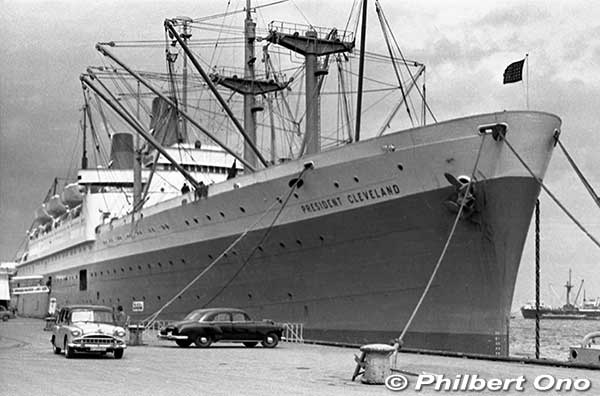
However, Mizuho Pier, called “Yokohama North Dock” or “North Pier” by the Americans, with seven berths, is still used by the U.S. Army and Navy today. The city hopes to see this substantial chunk of pier returned.
In the 1950s and 1960s, ocean liners docking at Osanbashi was a major event attracting many people eagerly welcoming relatives or friends visiting Japan or bidding them farewell to a faraway land.
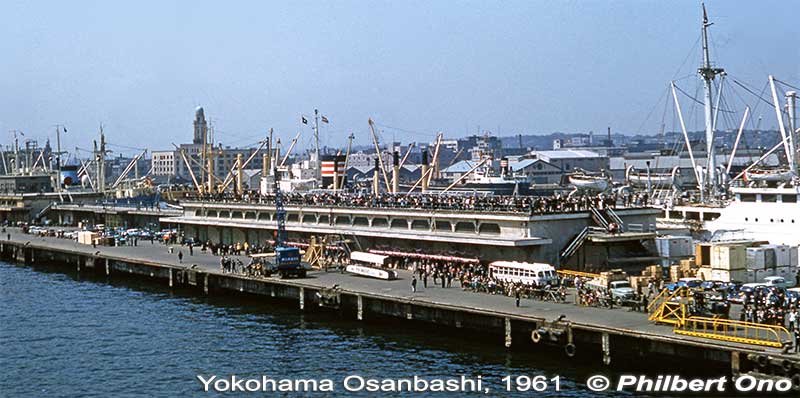
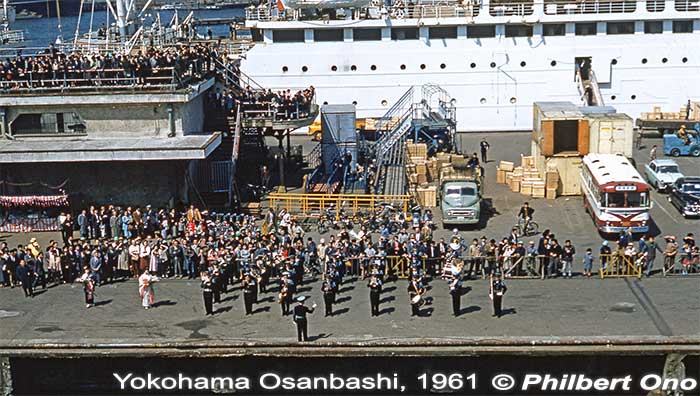
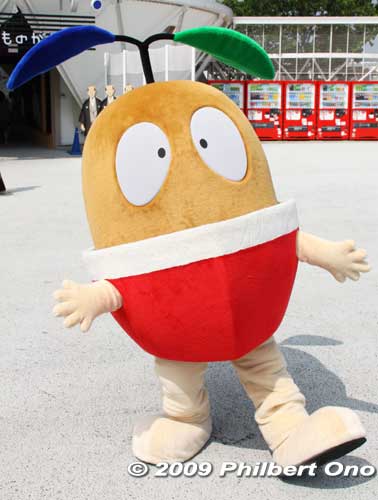
To prepare for international ocean liners coming for the 1964 Tokyo Olympics, Osanbashi was refurbished with a new cruise terminal. In 2002, this terminal was replaced by the current terminal building (“Whale’s Back”)
In March 1975, luxury ocean liner Queen Elizabeth 2 called on Japan for the first time during her maiden world cruise. She visited Kobe and then passed by a snow-capped Mt. Fuji before reaching Yokohama with 1,400 passengers.
At Osanbashi Pier, a whopping 520,000 people came to see her during her four days in port. She then sailed on to Honolulu where she also received many oohs and ahhs. QE2 visited Yokohama 19 more times until 2008.
Yokohama Port is also a sister port with Oakland Port, California; Vancouver Port, Canada; and Hamburg Port, Germany.
Taking much pride in its port town heritage, Yokohama has celebrated the anniversary of its port opening every 50 years or so. The last celebration was in 2009 when the Grand Exposition for Yokohama’s 150th Year (EXPO Y150 開国博Y150) was held near the Red Brick Warehouses for the 150th anniversary of Yokohama Port.
When your ship stops in Yokohama, walk around Osanbashi Pier and feel the history. Then stroll to any of the many sights below. Lots of options in Yokohama.
Yokohama Port shore excursions on foot
From Osanbashi Pier (大さん橋)


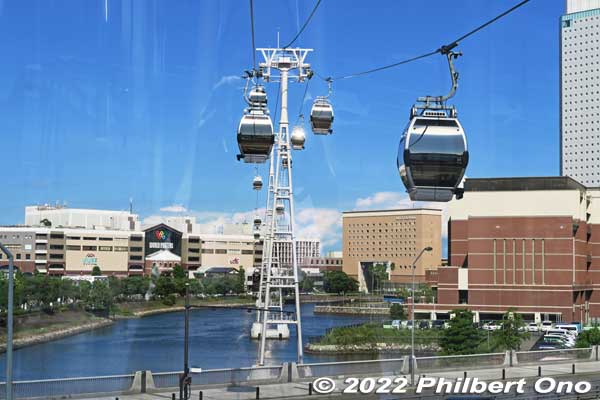
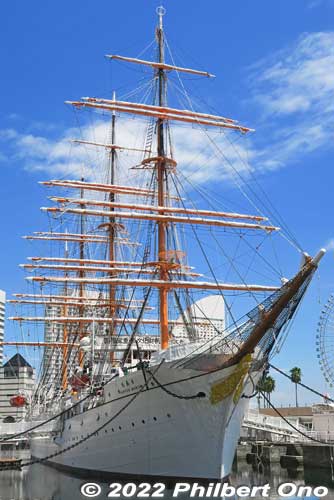
- Osanbashi Pier terminal building – Rooftop park open 24/7 to the public to watch the ships come and go. Go inside for cafes and gift shops.
- Zonohana Park – Remnant of the past. Nice views of your ship if it’s docked on the left side of Osanbashi Pier.
- Red Brick Warehouses – Originally built in 1911 as customs warehouses for the port. After major renovations, converted into a shopping complex and new tourist attraction in 2002. Currently closed for renovations until around Feb. 2023, but you can admire the exterior.
- Yokohama Customs – Built in 1934, an eye-catching building seen from Osanbashi as long as most of us can remmeber. One of the three iconic buildings in the port area dubbed the “Queen Tower.” The building still houses Customs offices. The public can visit the Customs Museum for free.
- Minato Mirai – Waterfront area with shopping malls, hotel, Pacifico Yokohama convention center, Yokohama Museum of Art, Rinko Park on the waterfront, Landmark Tower, and Minato-Mirai Station.
- Landmark Tower – Yokohama’s highest building with bird’s eye views of Yokohama Port. Also restaurants and shopping mall.
- Yokohama CosmoWorld – Amusement park highlighted by a ferris wheel with bird’s eye views of the port area.
- Nippon Maru museum ship – Grand sailing ship built in 1930 to train Japanese sailors. Retired in 1984. See the top deck and impressive decks below. Also see the Yokohama Port Museum showing the port’s history and model ships.
- Yokohama World Porters – Large shopping mall.
- Cup Noodles Museum – For instant noodle fans. Make your own Cup Noodles too.
- JICA Japanese Overseas Migration Museum – Japan’s biggest museum about Japanese emigrants who went to Hawaii, North America, and South America.
- Yokohama Air Cabin – New scenic ropeway linking JR Sakuragicho Station and Unga Park Station near Yokohama World Porters. Only 5 minutes if you don’t want to walk along the Kisha-michi Promenade. Not recommended if you’re afraid of heights. One-way fare is ¥1,000 (¥1,800 roundtrip) and ¥500 for kids. It opened in April 2021.
- Kisha-michi Promenade – Scenic boardwalk across the water to/from JR Sakuragicho Station. Formerly a rail line to the docks.
- Yamashita Park – Pleasant waterfront park made of rubble from the 1923 Great Kanto Earthquake. Nice views of Osanbashi Pier and your cruise ship if it’s docked on the right side.
- Yokohama Marine Tower – In Yamashita Park, bird’s eye view of the port area. Just renovated.
- Hikawa Maru museum ship – Former luxury ocean liner sailing between Japan and Seattle before and after World War II operated by NYK Line. Retired in 1960 and completely restored.
- Silk Museum/Center – First floor has a convenient drugstore-supermarket for food, snacks, drinks, etc. The silk museum explains Yokohama’s silk cultivation, export history, and weaving.
- Yokohama Port Opening Square – Small public park with a monument commemorating the sining of Japan–US Treaty of Peace and Amity between the U.S. and Japan on March 31, 1854.
- Yokohama Archives of History – Yokohama history buffs and researchers can use the reading room to examine books and documents. In the courtyard, see the descendant of the Tabunoki tree that witnessed the signing of the U.S.-Japan Treaty of Amity and Commerce in 1854.
- Nihon-Odori subway station – Take the subway to Tokyo (Shibuya).


From Daikoku Pier (大黒ふ頭)
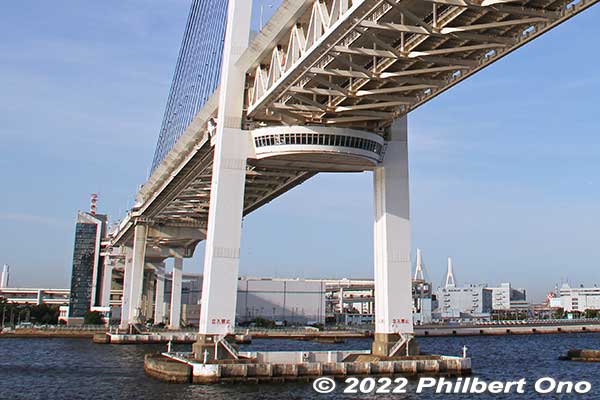
- Yokohama Bay Bridge Skywalk (横浜ベイブリッジスカイウォーク) – New attraction opened on June 25, 2022. Daikoku Pier is right outside Yokohama Bay Bridge. On weekends, you can walk partially across the bridge to the Sky Lounge overlooking the water where ships pass under the bridge. There’s an elevator on the bridge’s Sky Tower going up to the Sky Promenade walkway to the Sky Lounge. Open 11:00 a.m.–6:00 p.m. on Sat., Sun., and national holidays. Too bad it’s not open on weekdays too.
From Shinko Pier (新港ふ頭)
- Yokohama Hammerhead – Opened in Oct. 2019, small shopping mall and hotel complex which is also the pier’s cruise ship passenger terminal. The rooftop is a park good for spotting ships. Hammerhead refers to the large cargo crane which was used for cargo ships in the old days.
- Hammerhead crane – Next to Yokohama Hammerhead on the waterfront is Hammerhead crane, Yokohama Port’s first cargo crane installed here in 1914 when Shinko Pier was built. It was used for 88 years until 2001. It even survived the 1923 Great Kanto Earthquake.
Standing 30 meters high, it was made in the UK by Cowans Sheldon & Co. Ltd. It could carry up to 50 tons or cargo. Although it’s no longer in operation, it’s still functional. Now being preserved as historical industrial machinery in a waterfront park named Hammerhead Park. Five of these cranes were imported to Japan, and this is one of only three cantilever cranes which still exists in Japan. The other two are in Nagasaki Prefecture. Don’t you love these fishy nicknames at Yokohama Port? - Minato Mirai – See above for Osanbashi Pier.
Also see: Tokyo Port | Kobe Port | Hakodate Port
Links
Map: https://goo.gl/maps/b19Rc8AjWt3KzJXJ7
Port of Yokohama: https://www.city.yokohama.lg.jp/city-info/yokohamashi/yokohamako/port_of_yokohama.html
Yokohama cruise ship arrival/departure schedule (in Japanese): https://www.city.yokohama.lg.jp/kanko-bunka/minato/kyakusen/nyuko/
Content Navigator
Ports for Cruise Ships in Japan
- Cruise ship departure ports
- Japan’s popular ports of call
- Shore excursions
- Mega-ships and harbor bridges
- Japanese port history
- Port town songs
- Major Japanese Ports: Yokohama (Current page) | Tokyo | Kobe | Hakodate | Nagoya | Kanazawa | Toyama | Amami-Oshima Naze | Yakushima Miyanoura
- Ship comparison
- Japanese cruise ship advantages
- COVID-19 protocols
- Basic cruise rules
- Safety Record
- FAQ
- Asuka II
- Nippon Maru
- Pacific Venus
State of Japanese Cruise Industry in mid-2022
- COVID-19 not over yet
- International cruise ships in Japan
- Japan still closed to international cruising
- Essential Japanese Vocabulary

